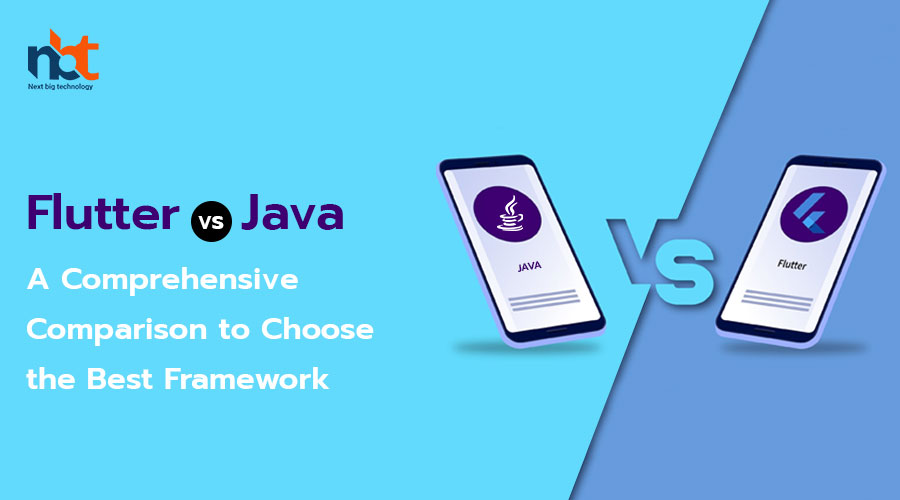Table of Contents
Introduction to Flutter and Java
In the ever-evolving landscape of app development, staying ahead of the curve is essential. Two names that frequently pop up in discussions about modern application development are Flutter and Java. Both are powerful tools in their own right, each bringing unique strengths to the table. Let’s delve into what makes them tick and how they complement each other in crafting exceptional digital experiences.
Flutter: A Brief Overview
Flutter, Google’s open-source UI toolkit, has been making waves since its inception. Launched in 2018, it has rapidly gained popularity among developers for its ability to create stunning native interfaces across multiple platforms from a single codebase. The key highlight of Flutter is its hot reload feature, allowing developers to see changes instantly, thereby speeding up the development process significantly.
Java: The Workhorse of Backend Development
Java, on the other hand, is a veteran in the world of programming languages. Renowned for its stability, scalability, and cross-platform compatibility, Java has been a cornerstone of enterprise-level application development for decades. With its robust ecosystem, Java powers the backend of many of the world’s most prominent applications, handling heavy lifting with ease.
The Synergy Between Flutter and Java
While Flutter excels in crafting beautiful user interfaces, Java shines in handling complex backend logic. When combined, they form a potent combination for building feature-rich applications that deliver both form and function. Here’s how they complement each other:
- Cross-Platform Capabilities: Flutter’s ability to compile to native code for multiple platforms coupled with Java’s cross-platform compatibility allows developers to target a broad audience without sacrificing performance or user experience.
- Rich User Interfaces: Flutter’s expressive UI framework enables developers to create visually stunning interfaces with ease. Integrating Java on the backend ensures seamless communication with servers, databases, and other external services, providing users with a smooth and responsive experience.
- Scalability and Performance: Java’s robust concurrency model and extensive library support make it an ideal choice for handling complex backend operations, ensuring that applications built with Flutter and Java can scale effortlessly to meet growing demands while maintaining optimal performance.
- Community Support and Ecosystem: Both Flutter and Java boast thriving communities and extensive documentation, making it easy for developers to find resources, libraries, and solutions to common challenges. Whether it’s troubleshooting UI issues in Flutter or optimizing backend code in Java, developers can tap into a wealth of knowledge and expertise.
Overview of Flutter Framework
In the ever-evolving realm of app development, Flutter has emerged as a game-changer. Developed by Google, Flutter is an open-source UI software development kit used to craft natively compiled applications for mobile, web, and desktop from a single codebase. Its popularity stems from its ability to deliver stunning user interfaces with remarkable speed and efficiency. Let’s delve into the depths of Flutter and uncover what makes it a preferred choice among developers worldwide.
What is Flutter? Flutter is a cross-platform framework designed to streamline the app development process. Launched in 2018, it has gained rapid traction within the developer community due to its unique features and capabilities. Unlike traditional frameworks that require separate codebases for different platforms, Flutter enables developers to write code once and deploy it across multiple platforms, including iOS, Android, web, and desktop.
Key Features of Flutter:
- Hot Reload: One of Flutter’s standout features is its hot reload capability, allowing developers to instantly view changes made to the code without restarting the application. This significantly accelerates the development process and fosters a seamless iteration cycle.
- Rich Set of Widgets: Flutter offers an extensive collection of customizable widgets for building beautiful, responsive user interfaces. These widgets adhere to the Material Design and Cupertino design guidelines, ensuring consistent app experiences across platforms.
- High Performance: Flutter apps are compiled directly to native machine code, eliminating the need for a JavaScript bridge. This results in superior performance and faster rendering, contributing to a fluid user experience.
- Expressive UI: With Flutter, developers have full control over every pixel on the screen, allowing them to create visually stunning and highly interactive interfaces. Its flexible architecture empowers designers to bring their creative visions to life effortlessly.
- Open-Source Community: Flutter boasts a vibrant and supportive community of developers, offering a plethora of packages, plugins, and resources to enhance productivity and solve common challenges. This collaborative ecosystem fosters innovation and continuous improvement within the framework.
Advantages of Using Flutter:
- Single Codebase: By writing code once and deploying it across multiple platforms, Flutter simplifies the development process and reduces time-to-market.
- Native Performance: Flutter’s native compilation ensures optimal performance, resulting in smooth animations, fast load times, and responsive UIs.
- Reduced Maintenance: With a single codebase, maintenance becomes more manageable, as updates and bug fixes can be applied universally.
- Unified Development Experience: Flutter provides a consistent development environment regardless of the target platform, streamlining the learning curve for developers.
- Support for Material Design and Cupertino: Developers can leverage Flutter’s built-in widgets to create apps that adhere to platform-specific design guidelines, enhancing user familiarity and satisfaction.
Overview of Java Framework
In the vast universe of programming languages, Java stands as a titan, powering a plethora of applications and systems worldwide. One of the key factors contributing to its ubiquity and versatility is the rich ecosystem of Java frameworks. These frameworks serve as scaffolding, providing developers with powerful tools and abstractions to streamline the development process, enhance productivity, and build robust, scalable applications. Let’s embark on a journey to explore the diverse landscape of Java frameworks.
- Spring Framework: At the forefront of Java enterprise development, the Spring Framework reigns supreme. Renowned for its lightweight nature and extensive features, Spring offers comprehensive support for building enterprise-grade applications. With modules for dependency injection, aspect-oriented programming, and transaction management, Spring simplifies complex tasks and promotes modular, loosely coupled designs. Additionally, Spring Boot, an extension of the framework, facilitates rapid application development by automating configuration and providing out-of-the-box functionality.
- Hibernate: Data persistence is a fundamental aspect of most applications, and Hibernate excels in this domain. As an object-relational mapping (ORM) framework, Hibernate bridges the gap between Java objects and relational databases, enabling seamless interaction and manipulation of data. By abstracting database operations, Hibernate eliminates the need for boilerplate SQL code, thereby accelerating development and promoting portability across different database systems. Its support for transparent persistence, caching, and lazy loading further enhances performance and scalability.
- Apache Struts: For building web applications following the Model-View-Controller (MVC) architecture, Apache Struts remains a popular choice. Leveraging servlets and JavaServer Pages (JSP), Struts simplifies the development of scalable, maintainable web applications by enforcing a clean separation of concerns. Its robust validation and form-handling capabilities, coupled with built-in support for internationalization and client-side validation, make it well-suited for enterprise-grade projects.
- JavaServer Faces (JSF): Developed as part of the Java EE platform, JavaServer Faces provides a component-based framework for building web applications with rich, interactive user interfaces. By abstracting common UI components and event handling, JSF fosters rapid development and promotes code reusability. Its support for AJAX, templating, and data binding simplifies the creation of dynamic, responsive web applications, making it a preferred choice for enterprise developers.
- Play Framework: Embracing the principles of reactive programming, the Play Framework offers a modern, lightweight alternative for building web and mobile applications. Built on top of Akka and Netty, Play provides a highly scalable, non-blocking I/O model that is well-suited for building high-performance, real-time applications. With support for asynchronous programming, RESTful APIs, and built-in testing tools, Play empowers developers to create responsive, resilient applications with ease.
Performance Comparison: Flutter vs. Java
In today’s fast-paced digital era, choosing the right development framework is crucial for ensuring optimal performance and user satisfaction. Flutter and Java are two prominent contenders in the realm of app development, each with its strengths and weaknesses. In this article, we’ll delve into a comprehensive performance comparison between Flutter and Java to help you make an informed decision for your next project.
Flutter:
Flutter, developed by Google, has gained immense popularity for its cross-platform capabilities and hot reload feature, allowing developers to see instant changes in the code. One of the primary reasons for Flutter’s appeal is its use of Dart, a language optimized for building user interfaces. This framework boasts of impressive performance metrics, owing to its native-like performance on both iOS and Android platforms.
Java:
Java, a veteran in the programming world, has been a cornerstone in software development for decades. Renowned for its robustness and scalability, Java is often the preferred choice for building enterprise-level applications. With its vast ecosystem of libraries and tools, Java provides developers with the flexibility to create diverse applications catering to various industry verticals.
Performance Comparison:
- Speed: When it comes to speed, Flutter holds a slight edge over Java due to its compiled nature. Flutter apps are compiled directly to native code, resulting in faster execution compared to Java, which relies on the Java Virtual Machine (JVM) for interpretation.
- Memory Usage: Flutter’s compiled approach also contributes to lower memory usage, as it eliminates the need for a runtime interpreter like the JVM. This makes Flutter apps more lightweight and responsive, especially on resource-constrained devices.
- User Interface (UI) Performance: Flutter’s UI rendering engine, powered by the Skia graphics library, ensures smooth animations and transitions, akin to native applications. On the other hand, Java’s UI performance heavily depends on the underlying platform-specific libraries, which may lead to inconsistencies across different devices.
- Development Productivity: Flutter’s hot reload feature significantly enhances developer productivity by reducing the time taken for iterative development cycles. Developers can instantly see the effects of code changes, thereby streamlining the debugging and testing process. Java, while offering robust development tools like IntelliJ IDEA and Android Studio, lacks the real-time feedback mechanism of Flutter’s hot reload.
- Platform Integration: Java, being a mature language, offers seamless integration with platform-specific APIs and features. This makes it well-suited for applications requiring deep integration with device hardware or system-level functionalities. Flutter, although rapidly evolving, may face challenges in integrating with certain platform-specific features due to its cross-platform nature.
Development Speed and Efficiency
In the dynamic landscape of software development, the twin pillars of speed and efficiency reign supreme. In an era where time is money and innovation drives progress, mastering the delicate balance between rapid development and optimal resource utilization is paramount for success.
Understanding Development Speed and Efficiency
Development speed refers to the rate at which software solutions are conceptualized, designed, implemented, and deployed. It’s the heartbeat of the development process, dictating how quickly a product can reach the market or how promptly it can respond to evolving user needs.
On the other hand, efficiency encompasses the judicious allocation of resources—be it time, manpower, or technology—to maximize output while minimizing waste. An efficient development process ensures that every effort contributes meaningfully to the end goal, fostering productivity and sustainability.
The Interplay Between Speed and Efficiency
At first glance, speed and efficiency might seem at odds with each other. After all, the pursuit of speed often conjures images of cutting corners and sacrificing quality, while efficiency implies a methodical approach that prioritizes optimization over haste.
However, the reality is far more nuanced. A symbiotic relationship exists between speed and efficiency, where each complements the other in a delicate dance of iteration and improvement.
Strategies for Accelerating Development Speed
- Agile Methodologies: Embrace Agile frameworks like Scrum or Kanban to foster iterative development cycles, enabling rapid feedback loops and adaptive planning.
- Automation: Leverage automation tools for routine tasks such as testing, deployment, and code reviews, freeing up developers to focus on high-impact activities.
- Cross-Functional Teams: Cultivate interdisciplinary teams comprising developers, designers, testers, and stakeholders to promote collaboration and streamline decision-making.
- Prioritized Backlog: Maintain a prioritized backlog of features and user stories, allowing teams to focus on delivering the most value with each iteration.
Techniques for Enhancing Development Efficiency
- Code Reusability: Encourage the reuse of existing code components and libraries to minimize redundancy and expedite development cycles.
- Continuous Integration/Continuous Deployment (CI/CD): Implement CI/CD pipelines to automate the build, test, and deployment processes, ensuring swift and reliable delivery of code changes.
- Performance Monitoring: Monitor system performance and user feedback proactively, identifying bottlenecks and areas for optimization early in the development lifecycle.
- Knowledge Sharing: Foster a culture of knowledge sharing and continuous learning within the team, enabling collective problem-solving and skill development.
The Path to Sustainable Innovation
In the quest for development speed and efficiency, it’s crucial to strike a balance between velocity and quality. While rapid iteration is essential for staying ahead in today’s competitive landscape, it should never come at the expense of long-term sustainability or user satisfaction.
By embracing a holistic approach that integrates speed and efficiency into every facet of the development process, organizations can unlock new possibilities for innovation while delivering value to their customers with unmatched agility.
User Interface (UI) Development Capabilities
In today’s digital age, where user experience reigns supreme, User Interface (UI) Development stands as a cornerstone in the creation of captivating digital experiences. From sleek mobile applications to immersive web platforms, UI development plays a pivotal role in translating complex functionalities into intuitive interfaces that resonate with users. Let’s delve into the fascinating realm of UI development and uncover its capabilities in shaping the digital landscape.
Understanding UI Development: UI development encompasses the process of designing and creating the interface through which users interact with digital products. It involves a harmonious blend of creativity, functionality, and usability to deliver seamless experiences across various devices and platforms. UI developers leverage a plethora of tools and technologies to bring designs to life while prioritizing factors such as responsiveness, accessibility, and aesthetics.
Crafting Engaging Experiences: At its core, UI development is about more than just aesthetics; it’s about understanding user behavior and crafting experiences that cater to their needs. Through meticulous attention to detail, UI developers ensure that every element, from buttons to navigation menus, contributes to a cohesive user journey. By employing principles of visual hierarchy, typography, and color psychology, they guide users effortlessly through interfaces, making interactions intuitive and delightful.
Bridging Design and Functionality: UI development serves as a vital bridge between design and functionality, translating static mockups into dynamic, interactive experiences. Collaborating closely with UX designers and backend developers, UI developers breathe life into designs while ensuring optimal performance and seamless integration with backend systems. Through the implementation of responsive layouts, fluid animations, and intuitive gestures, they strive to create interfaces that feel natural and immersive across devices and screen sizes.
Embracing Innovation: In an ever-evolving digital landscape, UI development continually pushes the boundaries of innovation. From adopting emerging design trends to harnessing the power of cutting-edge technologies like AR/VR and voice interfaces, UI developers are at the forefront of driving change and shaping the future of digital experiences. By staying abreast of industry trends and experimenting with new tools and techniques, they infuse projects with creativity and originality, setting new standards for user engagement.
Optimizing for Performance and Accessibility: In the pursuit of creating inclusive experiences, UI developers prioritize accessibility and performance. They meticulously optimize interfaces to ensure fast load times, smooth animations, and seamless interactions, regardless of device or network conditions. Moreover, they adhere to accessibility standards such as WCAG (Web Content Accessibility Guidelines), making digital products usable by individuals of all abilities and ensuring compliance with regulatory requirements.
Native Features Integration: Flutter vs. Java
In the world of app development, integrating native features seamlessly is crucial for delivering a smooth user experience. Two prominent contenders in this arena are Flutter and Java. Both offer unique approaches to native features integration, each with its own set of advantages and considerations. In this article, we’ll delve into the comparison between Flutter and Java regarding their native features integration capabilities.
Understanding Flutter:
Flutter, developed by Google, has gained significant traction in recent years for its cross-platform development capabilities. Its framework employs Dart, a language optimized for building user interfaces, enabling developers to create visually appealing apps that run smoothly on both Android and iOS platforms.
When it comes to integrating native features in Flutter, developers have several options. Flutter provides plugins that serve as bridges between the Dart codebase and platform-specific code written in Java (for Android) or Objective-C/Swift (for iOS). These plugins allow developers to access device functionalities such as camera, location, sensors, and more, ensuring a seamless user experience across platforms.
One of the key advantages of Flutter’s native features integration is its consistency. Since Flutter uses a single codebase for both Android and iOS, developers can implement and test native features more efficiently, reducing development time and effort. Additionally, Flutter’s hot reload feature enables developers to see changes in real-time, making the iteration process faster and more intuitive.
Exploring Java:
On the other hand, Java has long been a stalwart in the world of Android app development. As the official language for Android development, Java offers robust support for integrating native features directly into apps. Developers can leverage Android’s extensive set of APIs to access device functionalities and system services seamlessly.
Java’s native features integration capabilities stem from its deep integration with the Android ecosystem. With Java, developers can utilize Android Studio, the official IDE for Android development, which provides a comprehensive set of tools for building, testing, and debugging apps. This tight integration allows developers to harness the full power of the Android platform, optimizing performance and compatibility with a wide range of devices.
While Java offers unparalleled access to native features on the Android platform, it does have some limitations when it comes to cross-platform development. Unlike Flutter, which allows for code sharing between Android and iOS, Java requires separate codebases for each platform, potentially increasing development overhead and complexity.
Comparing the Two:
In comparing Flutter and Java for native features integration, several factors come into play:
- Development Efficiency: Flutter offers a more streamlined development process with its single codebase approach, while Java provides comprehensive tools for native Android development.
- Performance: Java’s deep integration with the Android platform may offer slight performance advantages over Flutter in certain scenarios, but Flutter’s optimized rendering engine can deliver impressive performance across devices.
- Cross-Platform Compatibility: Flutter excels in cross-platform development, allowing developers to write code once and deploy it on multiple platforms, whereas Java is primarily focused on native Android development.
- Community Support: Both Flutter and Java boast large and active developer communities, providing resources, libraries, and plugins to facilitate native features integration.
Community Support and Ecosystem
In the bustling landscape of modern business, one key factor often stands out as a catalyst for success: community support and ecosystems. Beyond mere transactions and profits, fostering a supportive community and building a robust ecosystem around a product or service can significantly elevate its impact and sustainability. Let’s delve into why community support and ecosystems are invaluable pillars of growth in today’s dynamic market.
The Essence of Community Support
At its core, community support embodies the spirit of collaboration, mutual aid, and shared goals. It transcends traditional customer-business relationships, evolving into a vibrant network of individuals united by common interests, values, or objectives. Within such communities, members aren’t just consumers; they are advocates, advisors, and even co-creators.
Community support manifests in various forms, from online forums and social media groups to offline meetups and events. These platforms facilitate open dialogue, feedback sharing, and knowledge exchange, fostering a sense of belonging and empowerment among participants. Whether it’s troubleshooting technical issues, sharing success stories, or providing constructive criticism, each interaction strengthens the community fabric and enhances its collective resilience.
The Power of Ecosystems
In the digital era, ecosystems have emerged as dynamic landscapes where interconnected entities collaborate and coexist, driving innovation and value creation. An ecosystem encompasses not only a company and its customers but also partners, developers, third-party vendors, and even competitors. By nurturing symbiotic relationships within this interconnected web, organizations can tap into a broader pool of resources, expertise, and opportunities.
Ecosystems thrive on interoperability and openness, allowing diverse entities to seamlessly integrate their offerings and create holistic solutions that address complex challenges. For example, a software platform may provide open APIs (Application Programming Interfaces), enabling developers to build complementary apps and services that enhance the overall user experience. In this way, the ecosystem expands organically, generating new revenue streams and enriching the value proposition for all stakeholders involved.
Driving Growth and Innovation
The synergy between community support and ecosystems is a potent catalyst for growth and innovation. By actively engaging with their communities, companies can gain invaluable insights into customer needs, preferences, and pain points. Armed with this knowledge, they can iteratively refine their products or services, ensuring they remain relevant and competitive in a rapidly evolving market landscape.
Moreover, ecosystems foster a culture of experimentation and collaboration, where diverse perspectives converge to spark creativity and drive breakthroughs. Through strategic partnerships and alliances, organizations can leverage each other’s strengths to co-create novel solutions that address emerging market demands or tackle pressing societal challenges. Whether it’s leveraging shared resources, accessing new distribution channels, or harnessing complementary technologies, the possibilities within an ecosystem are limitless.
Case in Point: Tech Giants and Their Ecosystems
The success stories of tech giants like Apple, Google, and Amazon underscore the transformative power of community support and ecosystems. Apple’s App Store, for instance, has evolved into a thriving ecosystem comprising millions of developers and billions of users worldwide. By providing developers with the tools and resources to create innovative apps, Apple has cultivated a vibrant ecosystem that continually expands the capabilities of its devices and enhances the user experience.
Similarly, Google’s Android ecosystem has flourished through collaboration with device manufacturers, app developers, and service providers. The open-source nature of Android has fueled innovation and diversity, empowering developers to create a rich array of apps and services that cater to diverse user needs and preferences.
Platform Compatibility and Deployment
In the fast-paced digital landscape, where technology evolves rapidly, ensuring platform compatibility and smooth deployment has become imperative for businesses aiming to stay ahead of the curve. With an array of devices, operating systems, and frameworks available, navigating this terrain can be daunting. However, with the right strategies, businesses can streamline their deployment processes and achieve seamless integration across various platforms.
Understanding Platform Compatibility:
Platform compatibility refers to the ability of software or applications to run effectively across different platforms, including operating systems (OS), devices, and browsers. In today’s interconnected world, where users access content from smartphones, tablets, laptops, and desktops, ensuring compatibility across these diverse platforms is paramount for user satisfaction and business success.
Key Considerations for Platform Compatibility:
- Cross-Platform Development: Embracing cross-platform development frameworks such as React Native, Flutter, or Xamarin allows developers to write code once and deploy it across multiple platforms, minimizing development efforts and ensuring consistency in user experience.
- Responsive Design: Adopting responsive design principles ensures that websites and applications adapt seamlessly to various screen sizes and resolutions, providing an optimal viewing experience for users across different devices.
- Browser Compatibility: Testing applications on multiple browsers and versions is crucial to identify and resolve compatibility issues. Leveraging tools like BrowserStack or Sauce Labs can streamline the browser compatibility testing process.
- API Compatibility: Ensuring compatibility with third-party APIs and services is essential for integrating with external platforms and leveraging their functionalities. Regularly updating APIs and maintaining backward compatibility helps in accommodating changes and ensuring smooth operation.
Deployment Strategies for Seamless Integration:
Effective deployment is key to delivering software solutions to end-users efficiently and minimizing downtime. Here are some strategies to streamline the deployment process:
- Continuous Integration/Continuous Deployment (CI/CD): Implementing CI/CD pipelines automates the build, test, and deployment processes, enabling rapid and reliable delivery of software updates. Tools like Jenkins, GitLab CI/CD, or CircleCI facilitate seamless integration and deployment workflows.
- Containerization: Adopting containerization technologies such as Docker allows applications to be packaged along with their dependencies, ensuring consistency across different environments and simplifying deployment across various platforms.
- Infrastructure as Code (IaC): Managing infrastructure through code using tools like Terraform or AWS CloudFormation enables automated provisioning and configuration of resources, ensuring consistency and repeatability in deployment processes.
- Blue-Green Deployment: Implementing blue-green deployment enables rolling out updates with minimal downtime by maintaining two identical production environments (blue and green) and switching traffic between them seamlessly.
Maintenance and Updates
In today’s fast-paced digital landscape, where technology evolves at a rapid pace, the importance of regular maintenance and updates cannot be overstated. Whether it’s your website, software, or even physical infrastructure, staying on top of maintenance and updates is crucial for optimal performance, security, and longevity.
Why Maintenance Matters: Maintenance is akin to giving your car a regular tune-up or changing the oil. It ensures that everything is running smoothly and efficiently. Similarly, in the realm of technology, regular maintenance involves tasks like software updates, security patches, and system checks to identify and fix any issues before they escalate.
Ensuring Security: One of the most significant reasons for keeping systems up-to-date is security. Cyber threats are ever-present, and outdated software or systems are prime targets for hackers. By promptly applying security patches and updates, you can plug vulnerabilities and safeguard your data, as well as your customers’ information, from potential breaches.
Improving Performance: Just like a well-maintained car runs better, regularly updating software and systems can enhance performance. Updates often include performance optimizations, bug fixes, and new features that can streamline processes, boost efficiency, and provide a better user experience. Ignoring updates can lead to sluggish performance, compatibility issues, and even system crashes.
Adapting to Change: Technology is constantly evolving, and what was cutting-edge yesterday may be obsolete tomorrow. Regular updates ensure that your systems stay relevant and adaptable to changing needs and trends. Whether it’s adopting new industry standards, complying with regulations, or integrating with emerging technologies, staying up-to-date puts you ahead of the curve.
Cost Savings in the Long Run: While it may seem like a hassle to keep up with maintenance and updates, the cost of neglecting them can be far greater. Downtime due to system failures or security breaches can result in lost productivity, revenue, and reputation damage. Investing in proactive maintenance is a small price to pay compared to the potential costs of reactive fixes after a crisis occurs.
Best Practices for Maintenance: Implementing a proactive maintenance strategy involves regular monitoring, scheduling updates, and staying informed about industry developments. Depending on the scale and complexity of your systems, you may opt for in-house maintenance or outsource to managed service providers who specialize in keeping systems running smoothly.
Scalability and Flexibility
In the ever-evolving landscape of business, scalability and flexibility have emerged as critical factors for success. Whether you’re a budding startup or a well-established enterprise, the ability to adapt to changing demands while seamlessly expanding operations is paramount. In this article, we delve into the essence of scalability and flexibility, exploring how they intertwine to drive growth and innovation.
Understanding Scalability:
Scalability refers to a business’s capacity to handle increased workload or growth without compromising performance or efficiency. It’s about building systems and processes that can easily accommodate growth without the need for significant overhauls or disruptions.
Key Elements of Scalability:
- Infrastructure: A scalable business invests in robust infrastructure that can be easily upgraded or expanded to meet growing demands. This includes scalable cloud services, flexible IT systems, and adaptable hardware.
- Processes: Scalability hinges on streamlined processes that can handle increased volume without sacrificing quality. Automating repetitive tasks and optimizing workflows are essential for scaling efficiently.
- Resources: From human resources to financial investments, scalability requires allocating resources in a way that allows for seamless expansion. This may involve hiring additional staff, securing funding, or investing in scalable technologies.
Embracing Flexibility:
Flexibility complements scalability by enabling businesses to pivot, adapt, and respond swiftly to changes in the market or internal dynamics. It’s about being agile and nimble in the face of uncertainty, allowing for innovation and experimentation.
Key Aspects of Flexibility:
- Agile Workforce: A flexible workforce is empowered to adapt to new challenges, roles, and responsibilities. Encouraging continuous learning, cross-functional training, and a culture of innovation fosters flexibility within the organization.
- Adaptable Strategies: Flexibility extends to strategic planning and decision-making. Businesses must be willing to reassess and adjust their strategies in response to shifting market trends, customer preferences, or competitive landscapes.
- Scalable Technologies: Leveraging scalable technologies such as cloud computing, AI, and IoT enhances flexibility by providing on-demand access to resources and enabling rapid innovation and deployment.
The Interplay Between Scalability and Flexibility:
While scalability focuses on long-term growth and capacity planning, flexibility addresses the need for agility and responsiveness in the short term. Together, they form a dynamic framework that empowers businesses to thrive in today’s fast-paced environment.
Benefits of Integrating Scalability and Flexibility:
- Adaptive Growth: Businesses can scale up or down as needed without being constrained by rigid structures or processes.
- Resilience: The ability to adapt quickly to market changes or unforeseen circumstances enhances resilience and mitigates risks.
- Innovation: A flexible and scalable business environment fosters innovation by encouraging experimentation and creative problem-solving.
- Competitive Advantage: Companies that excel in both scalability and flexibility gain a competitive edge by being better equipped to meet evolving customer needs and market demands.
Case Studies: Successful Implementations with Flutter and Java
In the dynamic world of app development, staying ahead demands innovation, adaptability, and the ability to harness cutting-edge technologies. Flutter and Java, two stalwarts in the realm of programming languages, have emerged as formidable choices for developers seeking versatility and efficiency. In this article, we delve into captivating case studies that illuminate the successful implementations achieved through the synergy of Flutter and Java.
The Rise of Flutter and Java
Flutter, Google’s UI toolkit, has gained widespread acclaim for its ability to craft natively compiled applications for mobile, web, and desktop from a single codebase. Its reactive framework empowers developers to build stunning interfaces with expressive and flexible designs, while its hot reload feature facilitates rapid iteration and experimentation.
Java, a veteran in the programming landscape, continues to reign supreme as a robust, object-oriented language renowned for its portability, performance, and extensive ecosystem. Its compatibility across various platforms and devices makes it an indispensable tool for crafting scalable and reliable applications.
Case Study 1: Banking on Efficiency
In a bid to revolutionize the banking experience, a leading financial institution sought to develop a feature-rich mobile app catering to diverse customer needs. Leveraging the power of Flutter for the frontend and Java for the backend, the development team embarked on a transformative journey.
Flutter’s widget-based architecture enabled the creation of a visually captivating interface that seamlessly adapted to different screen sizes and resolutions. Meanwhile, Java’s robust backend facilitated secure data storage, real-time transaction processing, and integration with legacy systems.
The result? A sleek, user-friendly app that streamlined banking operations, enhanced customer engagement, and garnered rave reviews on app stores. The seamless integration of Flutter and Java proved instrumental in delivering a cutting-edge solution that exceeded client expectations.
Case Study 2: Empowering E-Learning
In the realm of education, a pioneering e-learning platform sought to enrich the learning experience through personalized content delivery and interactive features. Armed with Flutter and Java, the development team set out to transform this vision into reality.
Flutter’s rich set of pre-designed widgets and customizable components accelerated the development process, allowing for the creation of an intuitive and visually compelling interface. Meanwhile, Java’s robust backend infrastructure facilitated seamless user authentication, content management, and analytics tracking.
The outcome was a feature-rich e-learning platform that captivated learners and educators alike. The seamless integration of Flutter and Java enabled real-time collaboration, personalized learning pathways, and seamless content delivery across devices, revolutionizing the e-learning landscape.
Conclusion: Choosing the Right Framework for Your Project
In the dynamic landscape of software development, selecting the appropriate framework for your project is akin to navigating through a maze. The plethora of options available can often bewilder even the most seasoned developers. However, armed with a clear understanding of your project’s requirements and careful evaluation of various frameworks, you can chart a path towards success. Let’s delve into the intricacies of choosing the right framework for your endeavor.
Define Your Project’s Requirements: Before embarking on the quest for the ideal framework, it’s imperative to define the requirements of your project meticulously. Consider factors such as scalability, performance, flexibility, and ease of maintenance. Are you developing a web application, a mobile app, or an enterprise-level software solution? Understanding the nature and scope of your project will serve as a compass guiding you towards the most suitable framework.
Evaluate Framework Options: With a myriad of frameworks available across different programming languages, conducting thorough research is essential. Assess the pros and cons of each framework in relation to your project requirements. For web development, popular choices include React.js, Angular, and Vue.js, each offering unique features and advantages. Similarly, for mobile app development, options like Flutter, React Native, and Xamarin present compelling propositions. Take into account factors such as community support, documentation, and ecosystem maturity during your evaluation process.
Consider Long-Term Viability: While it may be tempting to opt for the latest and trendiest framework, consider the long-term viability of your choice. Evaluate the framework’s roadmap, release cycle, and adoption trends within the developer community. A framework with strong community support and a stable development roadmap is more likely to withstand the test of time and evolve alongside your project’s needs.
Assess Learning Curve and Team Skillset: Another crucial aspect to consider is the learning curve associated with the chosen framework and the skillset of your development team. Opting for a framework that aligns with your team’s existing expertise can streamline the development process and minimize the learning curve. However, don’t shy away from investing in upskilling initiatives if the selected framework offers significant advantages for your project.
Factor in Performance and Scalability: Performance and scalability are paramount considerations, particularly for large-scale projects or applications with high traffic volumes. Evaluate the framework’s performance benchmarks, scalability features, and optimization capabilities to ensure it can handle your project’s requirements both now and in the future. Additionally, consider factors such as caching mechanisms, database integration, and server-side rendering to enhance performance where necessary.
Seek Feedback and Conduct Prototyping: Gaining insights from peers, industry experts, and online communities can provide valuable perspectives during the framework selection process. Engage in discussions, seek feedback from developers who have hands-on experience with the frameworks under consideration, and leverage online resources such as forums, blogs, and tutorials. Furthermore, consider conducting prototyping or proof-of-concept exercises using multiple frameworks to gauge their suitability for your project’s needs.
Thanks for reading our post “Flutter vs Java: A Comprehensive Comparison to Choose the Best Framework”. Please connect with us to learn more about Best Flutter vs Java Framework.























